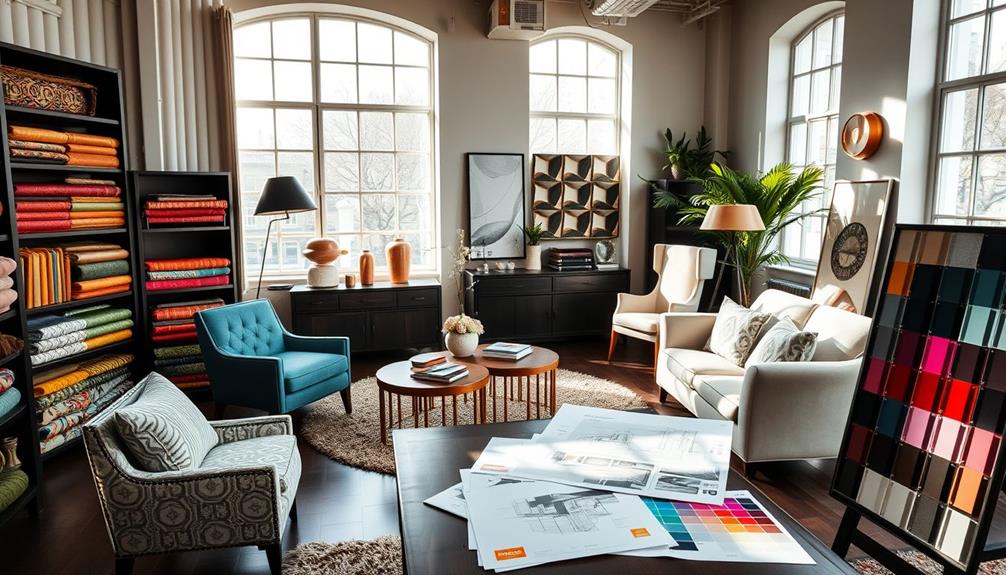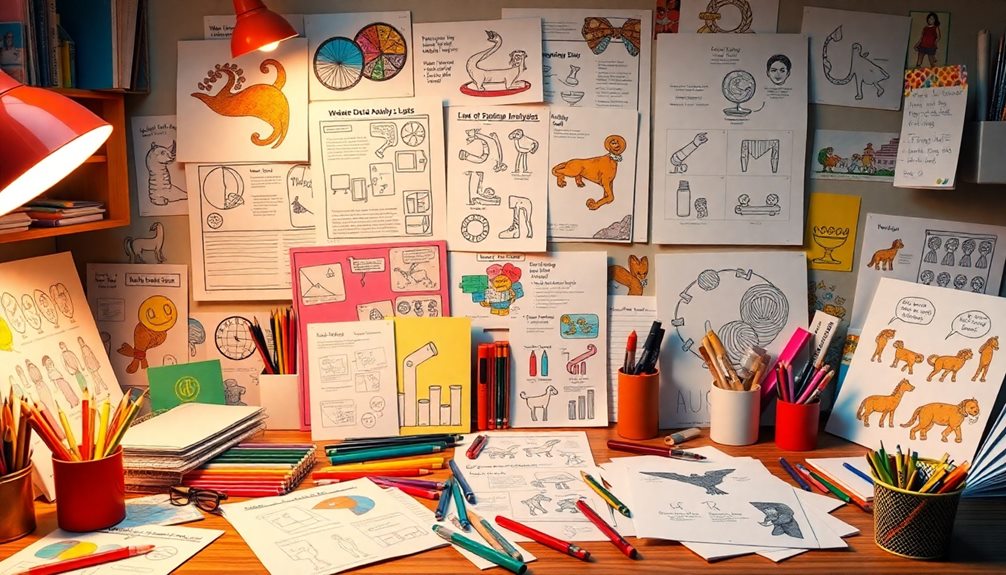Designing your home is all about expressing your personal style. Start by establishing a clear budget and creating a mood board to visualize your ideas. Choose a key inspiration object to guide your selections, then measure your space and create a layout plan. Select foundation furniture in neutral colors for versatility, and incorporate major design elements like lighting and colors that set the mood. Don't forget to add art and accessories for character, and personalize your space with items that hold meaning. If you're looking for more tips to refine your design journey, there's plenty to explore!
Key Takeaways
- Establish a clear budget by categorizing expenses and obtaining multiple contractor bids for cost comparison.
- Develop a mood board to visualize inspiration, colors, and textures that align with your desired atmosphere.
- Create a scaled room layout plan to optimize furniture placement and ensure adequate walking space.
- Select quality foundation furniture in neutral colors to provide flexibility and durability within your design.
- Personalize your space with meaningful art and accessories that reflect your personality and evoke emotional connections.
Establish a Clear Budget
Before diving into your interior design project, it's crucial to establish a clear budget. Start by categorizing your expenses into must-haves, nice-to-haves, and low-priority items. This approach helps you create a structured financial plan that keeps you on track.
Utilize a spreadsheet to track line items and cost estimates, making it easier to visualize your spending. Don't forget to include an additional 10-20% buffer for unexpected costs that may arise during the design process.
Next, obtain at least three bids from contractors. This allows you to compare costs and assess the quality of their work, empowering you to make informed financial decisions.
Measure your space accurately and create a layout before making any furniture purchases. This step prevents overspending on items that may not fit or function as needed.
Develop a Mood Board
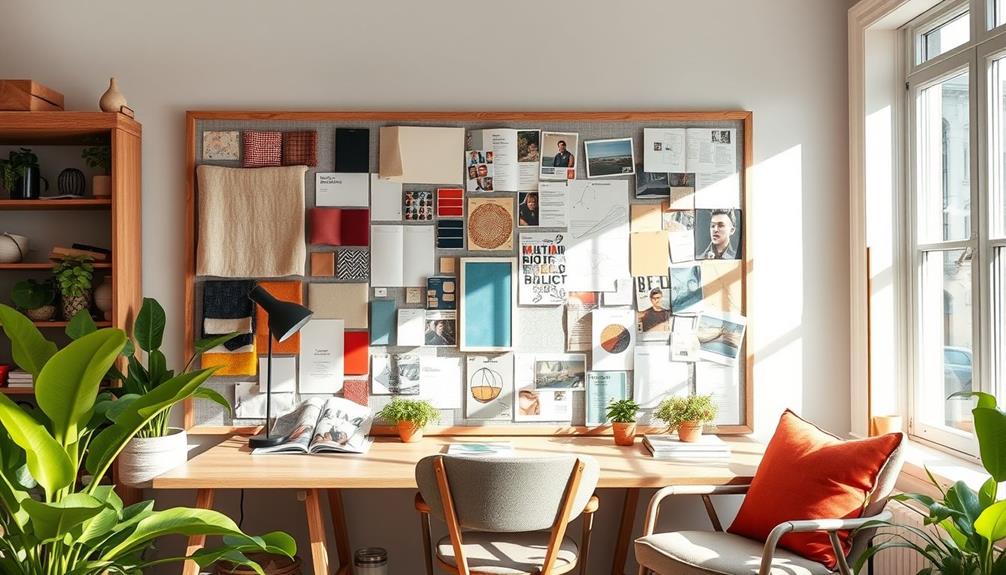
Creating a mood board starts with selecting inspiration objects that resonate with you, whether it's a piece of art or a favorite fabric.
Pay attention to color and texture choices, as they'll shape the overall vibe of your space.
This visual guide will help you maintain focus and direction throughout your design journey.
Selecting Inspiration Objects
A well-curated mood board can be the foundation of your interior design journey, guiding your choices and keeping your vision clear.
Start by identifying a springboard object, like a unique piece of art or furniture, that encapsulates your desired style. This object will help you make decisions about colors and materials throughout the design process.
Consider incorporating elements from Island Getaways to inspire a sense of adventure and relaxation in your design.
Next, create your mood board by collecting images, textures, and color swatches that resonate with you. This visual representation will clarify the overall atmosphere you want to achieve.
Utilize online platforms like Pinterest or Instagram to gather inspiration and pinpoint recurring themes that align with your vision.
When selecting inspiration objects, verify they fit within your budget and carry personal significance. This will lead to a more meaningful design that reflects who you are.
As you progress, regularly review and refine your mood board. This flexibility allows your aesthetic to grow as new ideas emerge, keeping your design journey dynamic and exciting.
Color and Texture Choices
Starting on your color and texture choices is an exciting step in developing your mood board. This visual tool helps you compile colors, textures, and images that resonate with your desired aesthetic.
Consider incorporating elements from modern farmhouse decor trends, such as earthy tones and natural materials, which can enhance the overall ambiance of your space. Begin by selecting a springboard object, like a piece of art or fabric, that encapsulates your style. This will guide your color and texture decisions throughout your design process.
Utilize platforms like Pinterest or create a physical collage to gather inspiration. Focus on recurring themes and colors that align with the atmosphere you wish to create in your space.
Don't forget to incorporate a mix of textures—soft textiles, smooth surfaces, and natural elements—to add depth and interest. Confirm these materials complement each other harmoniously.
Once you have your mood board, test paint colors and fabric swatches against it in the intended space. This step is vital to see how they interact with natural light and your existing furnishings.
Adjust your choices as needed before making final selections. By carefully curating your mood board, you'll set a solid foundation for the overall design, making your space truly reflective of your personal style.
Choose an Inspiration Object
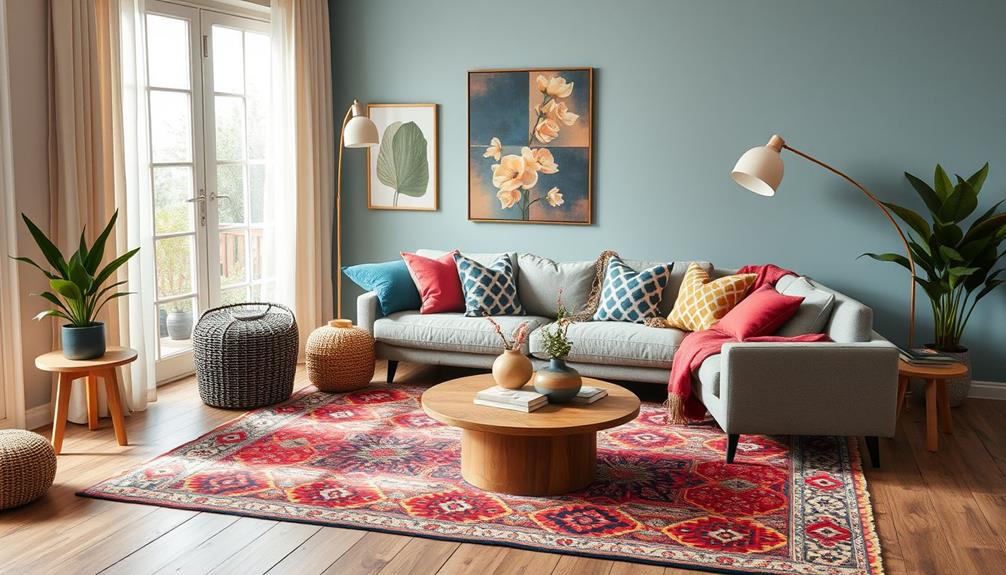
Selecting an inspiration object is essential in defining your home's interior design style. This object can be anything from a stunning piece of art to a unique piece of furniture that embodies your desired color palette and aesthetic. Choose something that resonates with you personally; it'll guide your decisions on colors, materials, and overall design direction.
To guarantee a harmonious design, use your inspiration object as a reference point. Analyze its textures, patterns, and colors, allowing these elements to inform your subsequent choices. Here's a simple table to help you evaluate potential inspiration objects:
| Inspiration Object | Key Features | How It Inspires Your Design |
|---|---|---|
| Artwork | Colorful and vibrant | Sets color palette for walls and accessories |
| Vintage Chair | Unique texture and shape | Influences furniture style and arrangement |
| Decorative Vase | Earthy tones and patterns | Guides material choices for other decor items |
| Area Rug | Geometric patterns | Determines layout and color scheme for the room |
Create a Room Layout Plan
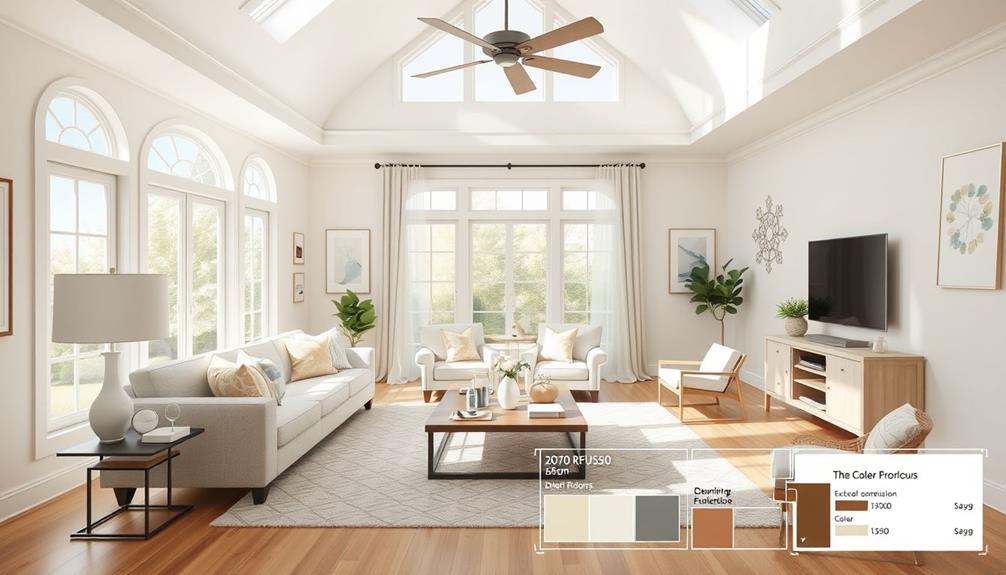
With your inspiration object in mind, creating a room layout plan becomes an essential next step. Start by taking accurate measurements of the room, including the dimensions of walls, windows, and doors. This guarantees that your furniture and decor will fit properly.
Once you have your measurements, use graph paper or digital floor planner apps to sketch a scaled layout. This visualization helps you see how furniture will fit and allows for smooth traffic flow. Additionally, consider how your chosen design might affect cleaning and maintenance; a well-planned layout can make it easier to keep your space tidy and organized, especially if you utilize services from a home cleaning service.
Consider the purpose of the room as you begin the design process. Prioritize seating and guarantee at least 18 inches of walking space around furniture for comfort and accessibility.
Begin by incorporating major furniture pieces, like sofas and tables, into your layout plan before adding smaller decorative items. This approach maintains a functional design.
Don't hesitate to experiment with different configurations and arrangements. Trying various layouts can help you find the most effective design that meets both your aesthetic preferences and practical needs.
Select Foundation Furniture
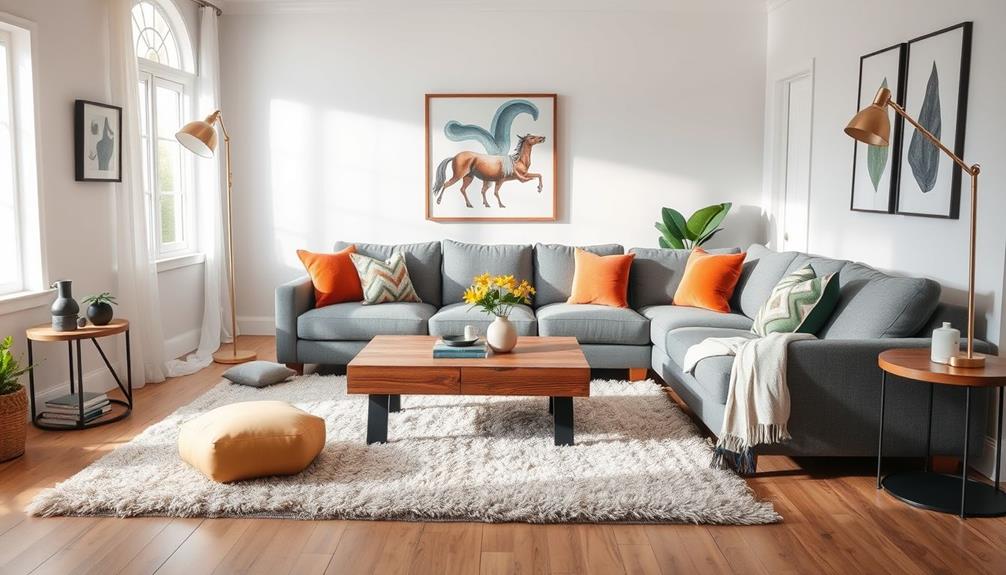
Often, choosing the right foundation furniture can make or break your interior design. Prioritize quality and durability when selecting key pieces like sofas, tables, and beds, as they greatly impact comfort and longevity in your space.
Opt for neutral colors for your foundation furniture; this flexibility allows you to change accessories and accents without replacing larger items. Incorporating best window treatments can further enhance your overall design and contribute to a cohesive look.
Consider the scale of your foundation furniture carefully. Avoid oversized pieces that can make a space feel cramped, and steer clear of small items that might get lost in larger areas.
Versatile options, like a sleeper sofa or a storage ottoman, can adapt to changing needs and maximize functionality within your home.
Layering textiles, such as throw pillows and blankets, enhances both comfort and aesthetic appeal. Not only do they add style, but they also protect your foundation furniture against wear and tear.
Pick Paint Colors
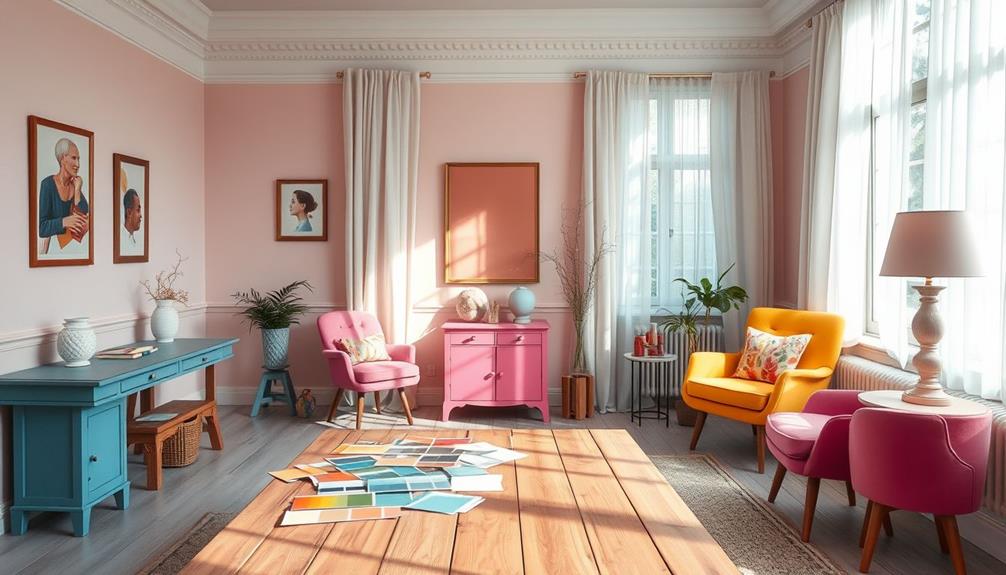
When picking paint colors, think about the mood you want to create in your space.
Testing paint samples on your walls at different times of day helps you see how light affects the color, ensuring you choose the right hue.
This careful selection process will enhance your overall design and atmosphere.
Color Mood Influence
Selecting the right paint colors can transform the mood of your home dramatically. The color mood influence is powerful, shaping how you feel in each space.
Warm tones like reds and yellows can energize and excite, while cool tones such as blues and greens create a calming atmosphere.
Here are three key points to reflect upon when choosing your paint colors:
- Warm Colors: Use reds, oranges, and yellows in social areas like the living room or dining room to promote energy and conversation.
- Cool Colors: Incorporate blues and greens in bedrooms or bathrooms for a soothing effect that encourages relaxation.
- Cohesive Palette: Select a few key colors and their varying shades to maintain harmony throughout your home. For example, a warm beige can create an inviting feel, while a gray with blue undertones can lend a cooler vibe.
Testing Paint Samples
Testing paint samples is an essential step in the design process, as it allows you to see how colors interact with your space. Start by purchasing multiple shades, applying large swatches on the walls. Observe how they change with natural light throughout the day.
To guarantee a cohesive look, test the samples against your existing furnishings and decor. Use a white background for testing paint samples; this helps highlight undertones and shifts in different lighting. Don't forget to take into account the finish—matte, satin, or gloss—as it can greatly affect the color's appearance.
Document your observations for each sample. Note how colors feel and the emotions they evoke. This can guide you in making your final color selection. Here's a simple table to help visualize your testing process:
| Sample Color | Emotional Response | Time of Day Observed |
|---|---|---|
| Soft Blue | Calm and Serene | Morning |
| Warm Beige | Cozy and Inviting | Afternoon |
| Deep Green | Grounded and Relaxed | Evening |
| Bright Yellow | Energetic and Happy | Midday |
Incorporate Major Design Elements
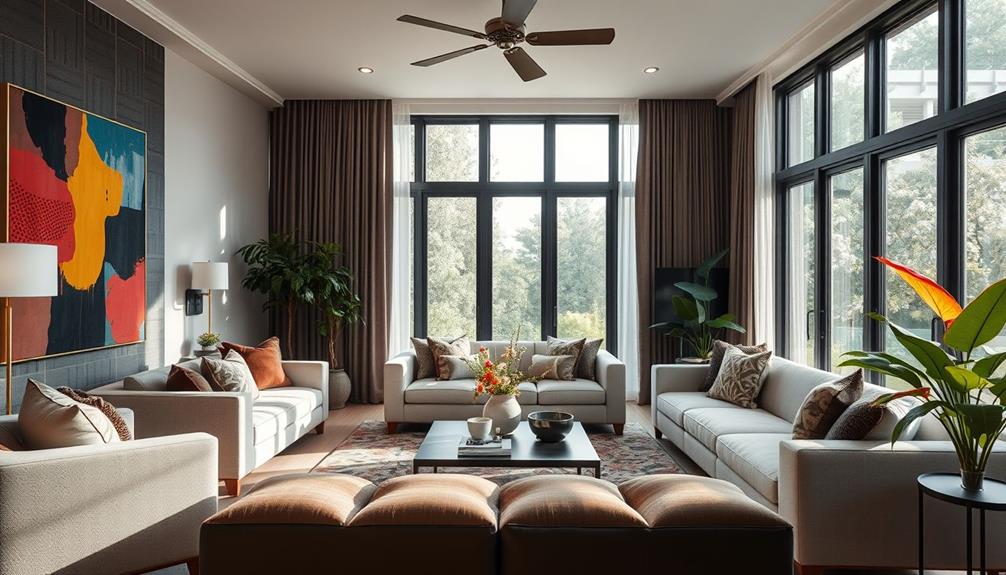
Creating a harmonious interior starts with incorporating major design elements that work together to define your space. By focusing on foundational furniture, color schemes, and lighting, you can craft an inviting atmosphere that reflects your style. When considering how to design a living room, it’s important to choose furniture that not only complements the space, but also serves a functional purpose. Selecting a color scheme that ties the room together is essential, whether it’s through coordinating furniture, wall paint, or accent decor. Additionally, strategic lighting can enhance the ambiance of the room, creating a warm and inviting feel that’s perfect for relaxation and entertaining.
Incorporating elements such as stylish wall clocks can't only enhance time management visually but also serve as a decorative piece that complements your overall theme.
1. Foundational Furniture: Choose quality pieces like sofas and tables that not only provide comfort but also set the tone for your home's design.
These elements are vital for durability and can easily adapt to future decor changes.
2. Color Schemes: Select colors based on the mood you want to evoke. Warm tones can create a cozy feeling, while cool tones promote calmness.
This choice influences how your space feels and can dramatically alter its ambiance.
3. Lighting: Lighting is essential in design. Utilize a mix of ambient, task, and accent lighting to enhance both functionality and aesthetics.
Proper lighting can transform the perception of colors and textures in your home.
Add Art and Accessories
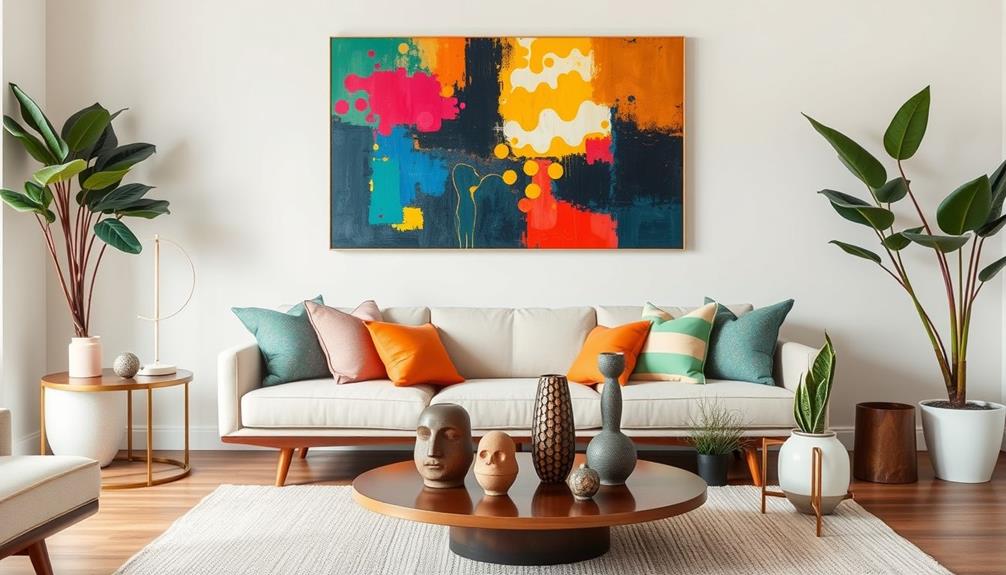
Art and accessories play an essential role in personalizing your space, adding character and depth that foundational elements alone can't achieve. When selecting art, choose pieces that resonate personally and reflect your unique story, as certain zodiac signs may correlate with perceived attractiveness and charm. This enhances the emotional connection you have with your home.
For a striking display, group smaller artworks into gallery walls; this transforms multiple pieces into an impactful installation that draws the eye.
Don't overlook the power of accessories. Decorative pillows and throws can add layers of texture and color, making your space feel warm and inviting. When incorporating these items, consider their scale and proportion to guarantee they fit harmoniously within the overall room design without overwhelming the area.
Mixing old and new items creates visual interest and enriches your aesthetic. By blending different styles, you'll add character that showcases your personality.
Personalize Your Space
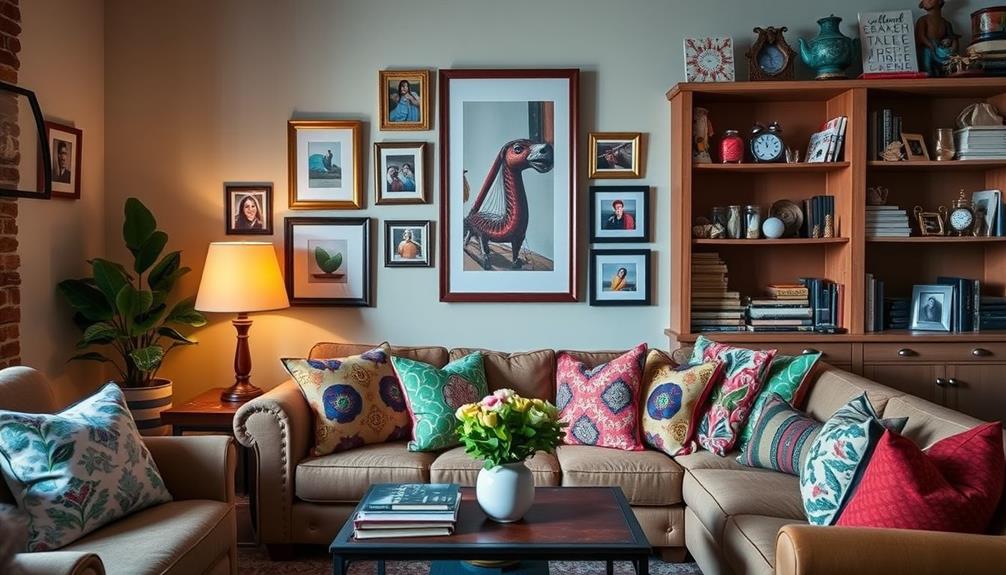
Personalizing your space is all about infusing it with elements that reflect your life and experiences. To truly make your home yours, consider incorporating meaningful design elements that tell your story.
Utilizing an extensive suite of professional services can also help enhance the functional and aesthetic aspects of your space, ensuring your design choices resonate with your unique style.
Here are three effective ways to personalize your space:
- Display Personal Items: Integrate family photos, travel souvenirs, or cherished heirlooms. These items create a tangible connection to your past and spark conversations.
- Create a Mood Board: Gather colors, textures, and styles that resonate with you. This visual guide will help you make decor choices that flow together beautifully, enhancing the overall aesthetic.
- Select Emotion-Evoking Art: Choose art and decor that evoke specific memories or feelings. Mixing modern and vintage pieces can also create a dynamic atmosphere that reflects your unique design narrative.
Additionally, leveraging resources like exclusive design insights can inspire your choices and elevate your space even further.
Allow for Future Changes

As your tastes evolve, it's important to design a space that can adapt alongside you.
Consider flexible furniture choices and layouts that allow for easy reconfiguration, making room for new items as needed.
Embrace Evolving Tastes
Home is where your personal style evolves, and designing it with flexibility in mind makes all the difference. By embracing evolving tastes, you can create a space that reflects your journey and adapts to your changing preferences. Here are three ways to achieve this:
1. Choose neutral colors: These serve as a timeless foundation, allowing you to easily introduce new accents and trends without overwhelming the space.
Additionally, incorporating safety features can enhance your home's functionality while maintaining a cohesive aesthetic.
2. Invest in versatile pieces of furniture: Select items that can serve multiple purposes or easily shift from one style to another.
This way, you can refresh your look without needing to replace everything.
3. Regularly update accessories and artwork: By reassessing your decor periodically, you can keep your home feeling current and aligned with your personal growth.
Embracing evolving tastes not only makes your space more adaptable but also fosters a deeper connection to your home.
It turns your living area into a true reflection of who you are, making it a comfortable sanctuary that grows with you.
Flexible Furniture Choices
When designing your space, flexible furniture choices play an essential role in accommodating future changes. Start by selecting modular or multi-functional pieces, like sofas that convert into beds or coffee tables with storage. These options can adapt to your evolving needs and room configurations.
Additionally, consider investing in items that are made from weather-resistant materials, especially if they'll be used in outdoor spaces, as they'll extend the lifespan of your furniture.
Invest in furniture with neutral colors or simple designs. This way, you can easily update your decor using accessories and textiles without the hassle of replacing larger items. Lightweight furniture is another smart choice, allowing you to rearrange your layout effortlessly as your lifestyle changes, whether you're hosting guests or creating a more open space.
Consider pieces that serve multiple roles, such as a dining table that doubles as a workspace. This maximizes utility, especially in smaller living areas.
Additionally, look for items that can be easily reupholstered or painted, ensuring they can be refreshed to match new trends or your personal preferences over time. By prioritizing flexible furniture choices, you'll create a home that evolves alongside you, making it both functional and stylish.
Space for New Items
Creating a space that allows for future changes is essential in maintaining a fresh and functional home. To achieve this, consider allocating at least 15-20% of your available space for new items. This guarantees you can adapt without overcrowding.
Here are three strategies to create that flexibility:
- Opt for Modular Furniture: Choose pieces that can be easily reconfigured or expanded. This way, you can adapt to your evolving needs and preferences without a complete overhaul.
- Design Versatile Layouts: Incorporate open areas and multi-functional spaces. This arrangement makes it easier to rearrange or add new items while maintaining a seamless flow throughout your home.
- Prioritize Smart Storage Solutions: Invest in built-in shelving or decorative storage bins that can accommodate future collectibles. This keeps your space organized and functional as your collection grows.
Regularly evaluate and update your design to reflect personal changes and tastes, guaranteeing your home remains a reflection of you while leaving room for those exciting new additions.
Conclusion
In the end, your home is a canvas waiting for your unique brushstrokes. By establishing a budget, creating a mood board, and selecting key pieces, you're not just decorating—you're crafting your story. Embrace the process, let your personality shine through every corner, and remember that design is ever-evolving. Just like life, your space should grow with you, reflecting who you are today while leaving room for who you'll become tomorrow. So, start painting your masterpiece!





